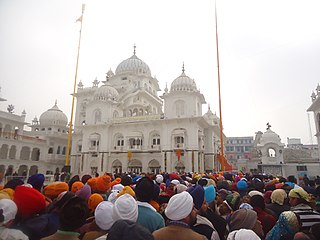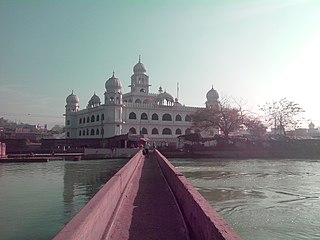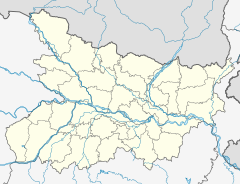A gurdwara or gurudwara is a place of assembly and worship for Sikhs. Sikhs also refer to gurdwaras as Gurdwara Sahib. People from all faiths are welcomed in gurdwaras. Each gurdwara has a Darbar Sahib where the Guru Granth Sahib is placed on a takhat in a prominent central position. Any congregant may recite, sing, and explain the verses from the Guru Granth Sahib, in the presence of the rest of the congregation.
The following outline is provides an overview of Sikhism, or Sikhi.

Anandpur Sahib, also referred simply as Anandpur, is a city in Rupnagar district (Ropar), on the edge of Shivalik Hills, in the Indian state of Punjab. Located near the Sutlej River, the city is one of the most sacred places in Sikhism, being the place where the last two Sikh Gurus, Guru Tegh Bahadur and Guru Gobind Singh, lived. It is also the place where Guru Gobind Singh founded the Khalsa Panth in 1699. The city is home to Takhat Sri Kesgarh Sahib, the third of the five Takhts in Sikhism.

Takht Sri Patna Sahib also known as Takhat Sri Harimandir Ji, Patna Sahib, is one of the five takhts of the Sikhs, located in Patna, Bihar, India.

The Delhi Sikh Gurdwara Management Committee (DSGMC) is organization in India responsible for the management of Gurdwaras, Sikh places of worship in Delhi. It also manages various educational institutions, hospitals, old age homes, libraries and other charitable institutions in Delhi. It is headquartered in Gurdwara Rakab Ganj Sahib, near Parliament House. Currently, the president of DSGMC is Harmeet Singh Kalka.

Gurdwara Sri Guru Gobind Singh Ghat, also known as Gurudwara Kangan Ghat, is a Sikh place of worship on the banks of the Ganges River approximately 650 m (710 yd) from Takht Sri Patna Sahib. In sikh historical sources, this is the place where Guru Gobind Singh threw his gold bangle (kangan) and passed on the knowledge of Sri Guru Granth Sahib Ji to Pandit Shiv Dutt, a devotee of Sri Ram Chandra.
About three kilometers east of Takht Sri Harmandir Sahib is where Guru Tegh Bahadur first alighted in a garden (bagh) belonging to Nawabs Rahim Bakhsh and Karim Bakhsh, nobles of Patna, and where the sangat of Patna along with the young Guru Gobind Singh came out to receive him back from his four-year-long odyssey. A shrine commemorative of the first meeting of Tegh Bahadur and Gobind Singh was established here. Its present building was constructed during the 1970s and 1980s. An old well which is still in use and a dried stump of the Imli tree under which the sangat met Guru Tegh Bahadur still exists.

Bihar (Hindi: Bihar,, in eastern India is one of the oldest inhabited places in the world with a history going back 3000 years. The rich culture and heritage of Bihar is evident from the innumerable ancient monuments that are dotted all over the state. Bihar is home to many tourist attractions and is visited by large numbers of tourists from all over the world. Around total 6 million tourists visit Bihar every year.
Hinduism is the most followed religion in Bihar, followed by nearly 82.7% of total population as per 2011 Census. Islam is the second-most followed religion which is followed by nearly 16.8% of population. There is also a significant population of Jains and Christians in the state.

Kiratpur, also known as Kiratpur Sahib, is a town in Rupnagar district of Punjab, India. The town is the location of the Gurdwara Patal Puri where many Sikhs take ashes of their deceased.

Hazur Sahib, also known as Takht Sachkhand Sri Hazur Abchalnagar Sahib, is one of the five takhts in Sikhism. The gurdwara was built between 1832 and 1837 by Maharaja Ranjit Singh (1780–1839). It is located on the banks of the Godavari River at the city of Nanded in the state of Maharashtra, India.
A takht, or taḵẖat, literally means a throne or seat of authority and is a spiritual and temporal centre of Sikhism. There are five takhts, which are five gurudwaras that have a very special significance for the Sikh community. Three are located in Punjab whilst the remaining two are located outside of it.

Tourism in Marathwada refers to tourism in the Marathwada region of Maharashtra state in India. Aurangabad is a regional headquarters in Marathwada, and the tourism capital of Maharashtra state. Out of the four UNESCO World Heritage Sites in Maharashtra, two are in the Marathwada region. There are also 110 monuments in Marathwada which are protected by Government of Maharashtra and recognized by Archaeological Survey of India.
Religious tourism in India is a focus of Narendra Modi's national tourism policy. Uttarakhand has been popular as a religious and adventure tourism hub.

The 350th Prakash Parv or birth anniversary of Guru Gobind Singh ji was celebrated in January 2017 in Patna, India. 2017 is the year of the 350th anniversary of the 10th Sikh Guru, a spiritual master, warrior, poet and philosopher. At the date of this anniversary, a number of events was organized on the occasion in Patna marking a grand celebration in their history.
Gaighat is a neighbourhood of Patna in the eastern state of Bihar in India. It is located on the southern bank of river Ganges in Patna. The southern flank of Mahatma Gandhi Setu bridge connecting Patna and Hajipur rises from Gaighat in Patna. One end of Pontoon Bridge (Peepapul) connecting Patna and Hajipur over the river Ganges is also located in the area. Gaighat is part of the wider Alamganj area in Patna.
The Gurdwara Gyan Godri Sahib, also known as Gurdwara Sri Gyan Godri Sahib, meaning "treasure of knowledge" was one of the holiest Gurdwara at Har Ki Pauri, Haridwar in the state of Uttarakhand, India. It existed at the place where The Bharat Scouts and Guides office exists today at the market in Subhash Ghat of Har Ki Pauri which is verified by Municipal Corporation Haridwar records of 1935.
Gurdwara Guru Singh Sabha, Kedli Kalan, is one of the oldest gurdwara of Eastern India.









